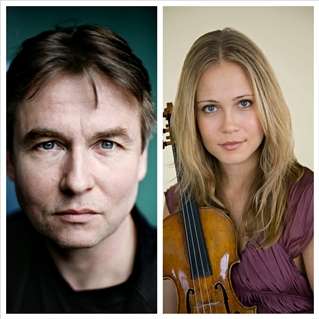|
Back
The Painter on the Dias New York
Avery Fisher Hall, Lincoln Center
10/30/2013 - & October 31, November 1*, November 2, 5, 2013
Maurice Ravel: Suite from Ma Mère l’Oye
Esa-Pekka Salonen: Violin Concerto
Jean Sibelius: Symphony No. 5 in E-flat major, Opus 82
Leila Josefowicz (Violin)
New York Philharmonic Orchestra, Esa-Pekka Salonen (Conductor)

E.-P. Salonen/L. Josefowicz (© Katja Tähjä/Berkshire Review)
Suddenly! The New York Philharmonic!
I see no other way to say this. Other orchestras have their character, but the San Diego Symphony, which gave their concert last week, was simply prosaic. And their music, like a bowl of nicely made Jello, remained uncomforably for a few days, waiting...waiting...
I guess it was waiting for the New York Philharmonic which sounded better than ever. For Esa-Pekka Salonen, whose visits here are far far too rare, gave it a gumption, a lift, an exuberance in all three of his pieces last night.
For the opening Ravel Mother Goose, Mr. Salonen needed no baton. He painted the pictures, he frequently gave too many pauses, he turned First Chair Violin Glenn Dicterow’s solo into a micro-concerto. But Mr. Salonen had a purpose. He wanted to show what we all knew already, that Maurice Ravel never had to paint large canvasses (that was left to his Mussorgsky orchestration). His was the most delicate pinpointing of harps and flutes and bells and luscious strings. And with that baton missing from Mr. Salonen’s hands, without the need to actually cue in these fine orchestral voices, he could paint this picture with Japanese delicacy.
(This is no supposition. Ravel’s countryside house is filled with Japanese prints and drawings, obviously the ultimate art for him.)
The second work was Esa-Pekka Salonen’s own. Or rather a Violin Concerto he composed with the help of the great Canadian-American violinist Leila Josefowicz, who has monopolized its performances worldwide. But then, she has instincts for modern composers, she has the fingers to play anything. And in this work, which I heard for the first time, she has the breadth for a half-hour of almost non-stop playing.
What I have always enjoyed most about Mr. Salonen’s compositions, is that he never does anything with an instrument that isn’t supposed to be done. And in these four movements, while it takes amazing agility for everybody–even the percussion section, which plays a duet with Ms. Josefowicz–it sounds like it’s written for an orchestra, not an experimental ensemble.
In this sense, conductor Salonen and conductor Mahler were alike in respecting their players and knowing how to orchestrate. The colors here were splendid, but the piece did belong to the soloist.
She started with a toccata-cadenza with a few intonations of vibraphone and marimba. She ended with mysterious sounds, a kind of farewell, yes. But as Mr. Salonen explains, “it is something coming to an end, and something new being born out of the old.”
The two middle movements were most affecting. The “slow” second movement was “a room...silent…heartbeats...” and yes, the taps on the drum were all too human and the soloist ruminated. The third movement was not jolly or happy. It was manic, ferocious, an orgy of instrumental liquor and California drugs, not a bacchanal, but a vigorous picnic, with drums playing, a folk tune in the distance (was this by Salonen?) and the joy of California dreamin’.
Yet for all four movements, one knew this could be a great showy and beautiful concerto for any titan. A shame, perhaps, that Ms. Josefowicz is the only “standard” performance. I could see both Hilary Hahn and Gil Shaham taking it in their own ways.
Mr. Salonen was so convincing in these two works that I wondered–for a nano-second–why he was doing that old codger Jean Sibelius at the end. Pretty dumb, for of course. Esa-Pekka Salonen was born in Suomi (the Finnish name), and after his 17 years with the Los Angeles Philharmonic, he was in the forefront of the Finnish Renaissance.
Under his baton (for he gave up the stick only for the Ravel), he transformed the architectural Jean Sibelius Fifth Symphony into a work of velocity and transparency. Trumpets, horns and trombones sang out, the second movement had string filaments which echoed Mendelssohn. But the last movement was given more than a strength, it had a religious chorale mightiness.
Perhaps Mr. Salonen lengthened the chorale at the start of the movement, but perhaps that was only so we could feel the strength even more with its all out climax.
Whatever it was, Mr. Salonen’s New York Philharmonic this week–and his performance with a chamber group of the orchestra in Sub-Culture on Bleecker Street next week–should prove that he needs to let his London Philharmonia fend for itself. Alan Gilbert is fine with the Phil, but Mr. Salonen gives it a different energetic and memorable vibrancy.
Harry Rolnick
|